The Ultimate Guide to Visiting Kom Ombo Temple, Egypt
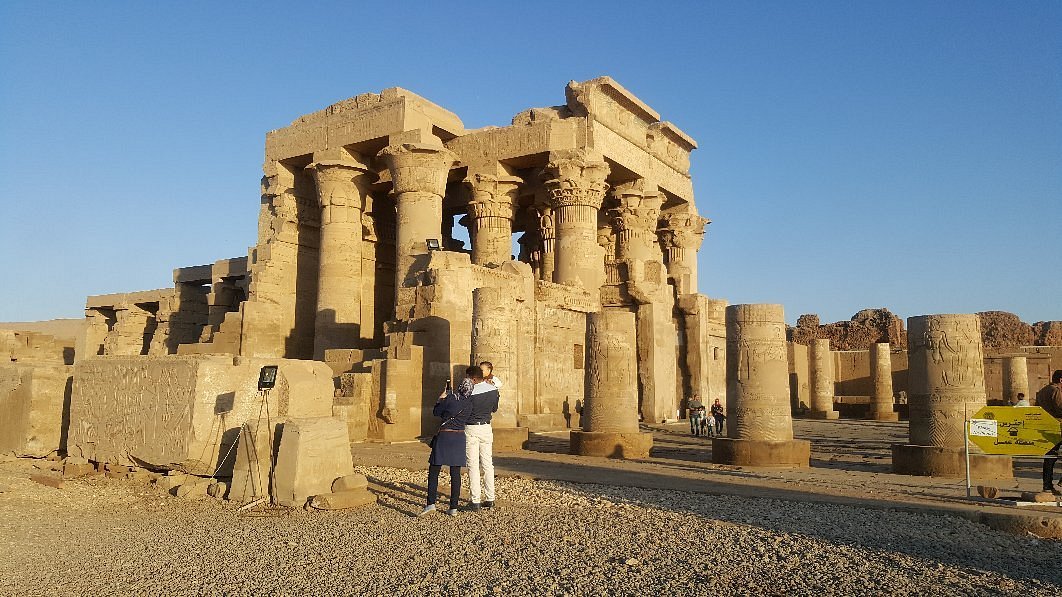
I. Introduction to Kom Ombo Temple
The Kom Ombo Temple is a remarkable historical site located in the city of Kom Ombo in southern Egypt. It is an ancient temple dedicated to two Egyptian deities, Sobek and Horus the Elder. This unique temple stands out from others in Egypt due to its symmetrical design, featuring two separate entrances, two mirror-image sanctuaries, and two courtyards. The temple offers a fascinating glimpse into ancient Egyptian religious practices and architectural achievements, making it a must-visit destination for history enthusiasts and tourists alike.
The historical significance of Kom Ombo Temple
The Kom Ombo Temple was built during the Ptolemaic dynasty, from the 2nd century BC to the 1st century AD. It was constructed on the site of an older temple that dates back to the New Kingdom period. The temple was primarily dedicated to the crocodile-headed god Sobek, associated with fertility, strength, and protection. Additionally, the temple honoured Horus the Elder, the falcon-headed deity who represented kingship and the rising sun.
The reliefs and carvings within the temple depict various mythological scenes and rituals, illustrating the ancient Egyptians' beliefs and practices. Visitors can marvel at the well-preserved hieroglyphics and learn more about the ancient culture and religious customs.
Location and accessibility
The Kom Ombo Temple is situated on the east bank of the Nile River, approximately 45 kilometres north of Aswan. It is easily accessible by both road and water transportation. Many tourists visit the temple during a Nile River cruise between Aswan and Luxor.
To reach the temple by road, one can take a taxi or hire a private car from Aswan or any nearby city. The journey offers breathtaking views of the Nile and the surrounding landscapes.
It is important to note that the temple may get crowded, especially during peak tourist seasons. It is advisable to plan the visit early in the morning or later in the afternoon to avoid larger crowds and to fully enjoy the serene ambience of the temple complex.
Visitors to the Kom Ombo Temple are advised to wear comfortable clothing and shoes suitable for walking. It is also recommended to bring sun protection, such as a hat and sunscreen, and drinking water to stay hydrated during the visit.
Overall, the Kom Ombo Temple is a remarkable historical site that unveils the ancient Egyptian civilization's religious beliefs and architectural prowess. Its unique design and historical significance make it a top attraction for travellers exploring Egypt's rich history and culture.

II. History and Architecture of Kom Ombo Temple
Background and Construction of the Temple
Kom Ombo Temple, located in Egypt, is a fascinating historical site that attracts tourists worldwide. The temple was constructed during the Ptolemaic dynasty in the 2nd century BC and stands on a hill overlooking the Nile River.
According to Wikipedia, the temple was dedicated to two deities, Sobek (the crocodile god) and Horus (the falcon-headed god). The temple's construction took several generations, with different rulers adding their additions and decorations over time.
Kom Ombo Temple is a religious site and an architectural masterpiece. The temple complex is symmetrical, with two parallel entrances and identical layouts. This unique design is known as a "dual temple," and it is one of its most striking features.
Unique Dual Temple Design
The dual temple design of Kom Ombo is a rare architectural style found nowhere else in Egypt. The temple consists of two identical sections, each dedicated to a different deity and containing separate sanctuaries, courts, and halls. Some notable features of the temple's design include:
- Double Hypostyle Halls: The temple has two large hypostyle halls with columns decorated with intricate carvings and hieroglyphics. These halls were used for various religious ceremonies and gatherings.
- Double Sanctuaries: One section of the temple is dedicated to Sobek, the crocodile god, while the other is to Horus, the falcon-headed god. Each sanctuary has its altar and a statue of the respective deity.
- Dual Courtyards: The temple has two open courtyards surrounded by colonnades. These courtyards were used for rituals, processions, and other religious activities.
- Carvings and Inscriptions: The temple's walls are adorned with intricate carvings and hieroglyphics that depict ancient Egyptian mythology, religious rituals, and historical events.
Visiting Kom Ombo Temple is not only a chance to explore the fascinating history of ancient Egypt but also an opportunity to appreciate the unique architectural design of the dual temple. Don't forget to bring your camera to capture the intricate carvings and details that make this temple a must-visit destination for history and architecture enthusiasts.
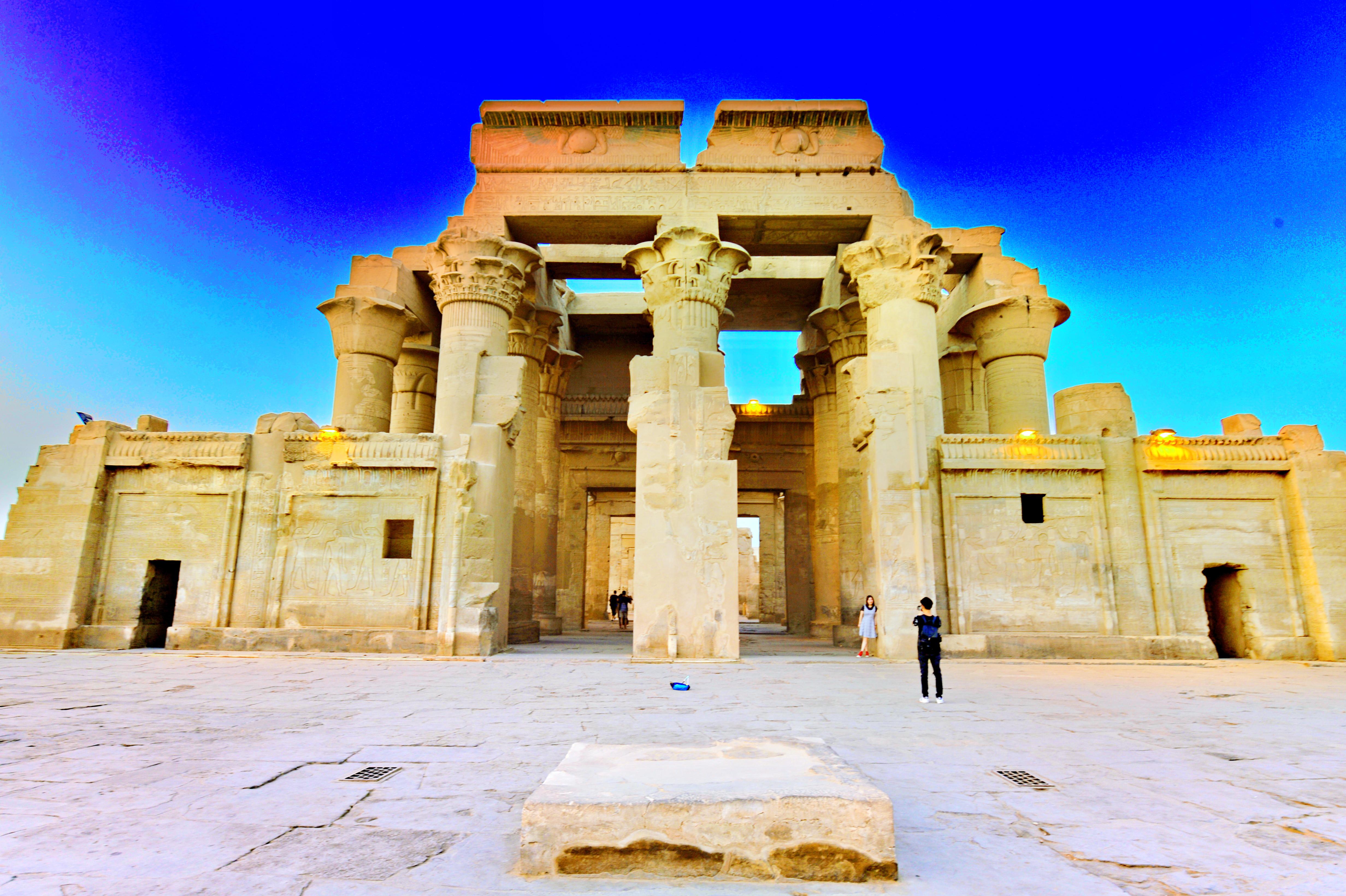
III. God Worships at Kom Ombo Temple
When visiting the mesmerizing Kom Ombo Temple in Egypt, visitors are immersed in the rich history and mythology of the ancient Egyptians. Dedicated to the worship of multiple deities, this temple holds great significance in Egyptian mythology. Here are some of the gods worshipped at Kom Ombo Temple and their importance in Egyptian culture.
Gods worshipped at the temple:
1. Sobek: Sobek, the crocodile-headed god, was one of the primary deities worshipped at Kom Ombo Temple. Associated with the Nile and fertility, Sobek was believed to have protected the people from the dangers of the river and its creatures. As the god of creation, he was also associated with fertility and rebirth.
2. Horus the Elder: Horus, the Elder, also known as Haroeris, was another important deity worshipped at Kom Ombo Temple. He was associated with the sky and kingship and was depicted with the head of a falcon. As the son of Osiris and Isis, Horus the Elder played a vital role in Egyptian mythology, symbolizing protection, courage, and victory.
Importance of each deity in Egyptian mythology:
Sobek:
- Sobek was considered the protector of the people, guarding them from the dangers of the Nile.
- Egyptians believed that Sobek created the Nile and its fertile lands, ensuring their livelihoods.
- Sobek was often associated with power, fertility, and renewal.
Horus the Elder:
- Horus the Elder was one of the oldest and most significant gods in Egyptian mythology.
- He represented the pharaohs and the divine authority they held.
- Horus the Elder was also associated with the sun, protection, and the divine balance between order and chaos.
Visitors to Kom Ombo Temple can explore the intricate carvings and hieroglyphics that depict the stories and legends associated with these deities. Learning about the myths and beliefs of the ancient Egyptians adds a deeper understanding and appreciation for the historical and cultural significance of the Kom Ombo Temple.
This is only briefly introducing the gods worshipped at Kom Ombo Temple. For a more in-depth exploration, you can refer to Ancient Egyptian religion on Wikipedia.

IV. Key Features of Kom Ombo Temple
The Kom Ombo Temple, situated on the banks of the Nile River in Egypt, is a fascinating archaeological site that offers a glimpse into ancient Egyptian culture and religious practices. The temple complex is renowned for its unique double design, with twin entrances and identical chambers on each side. Here are some key features of the Kom Ombo Temple:
A detailed description of the main structures within the temple complex
1. Twin Sanctuaries: The most striking aspect of the Kom Ombo Temple is its dual design. It consists of two identical sanctuaries, each dedicated to a different set of gods – the left side is devoted to the crocodile-headed god Sobek. In contrast, the right side is dedicated to the falcon-headed god Horus.
2. Hypostyle Halls: The temple complex features two spacious halls, one on each side. These halls are adorned with beautifully carved columns and walls depicting mythological scenes and religious rituals.
3. Inner Sanctuary: Within each sanctuary, there is an inner chamber known as the Holy of Holies. These chambers house the cult statues of the respective gods and are considered the most sacred spaces within the temple.
Explanation of their significance and purpose
1. Twin Sanctuaries: The dual design of the Kom Ombo Temple reflects the ancient Egyptian belief in duality and balance. The temple was dedicated to both Sobek and Horus, symbolizing the harmony between the natural and divine forces in the world.
2. Hypostyle Halls: The halls served as gathering places for religious rituals and ceremonies. The intricate reliefs and carvings on the columns and walls provided visual representations of the religious beliefs and myths of ancient Egypt.
3. Inner Sanctuary: The inner sanctuaries were considered the most sacred spaces within the temple complex. They housed the cult statues of the gods, believed to be the physical embodiment of the deities. These statues were cared for by the temple priests and were the focal point of religious worship.
Exploring the Kom Ombo Temple is a captivating experience that allows visitors to appreciate ancient Egyptian temples' architectural brilliance and religious significance. Make sure to visit this remarkable site on your next trip to Egypt!
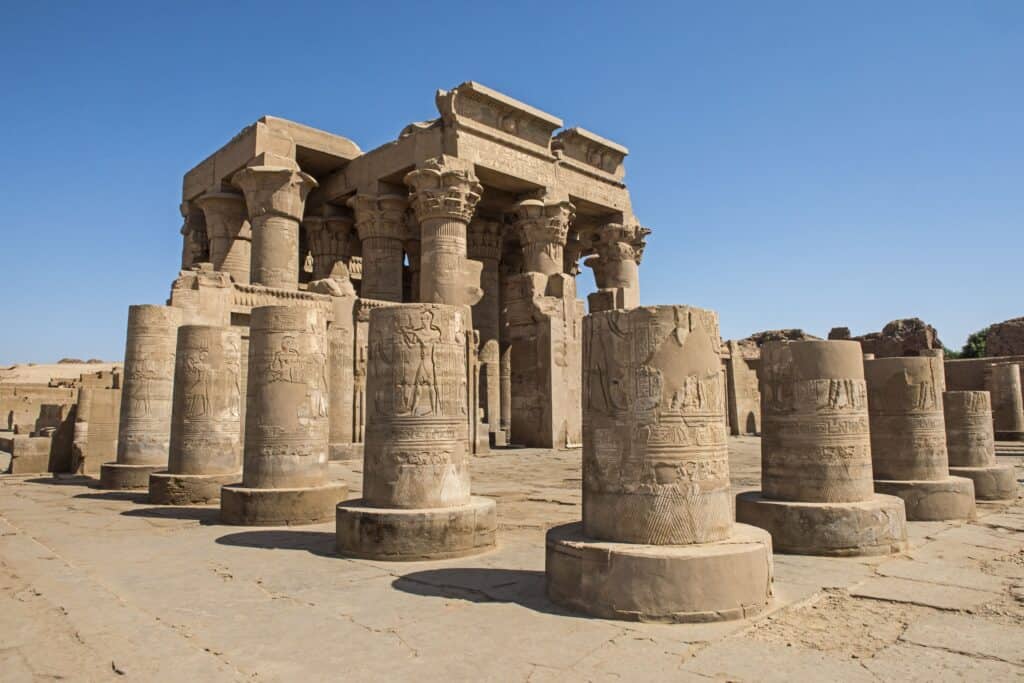
V. Wall Reliefs and Hieroglyphics at Kom Ombo Temple
When visiting the Kom Ombo Temple in Egypt, one cannot help but be mesmerized by the intricate wall reliefs and hieroglyphics that adorn the temple's walls. These ancient carvings provide a glimpse into ancient Egypt's rich history and mythology. Here's a closer look at what you can expect to see and how to interpret the stories depicted on the walls.
Exploration of the intricate carvings and inscriptions
Walking through the temple, you'll be surrounded by stunning wall reliefs and intricate hieroglyphic inscriptions. These carvings represent various gods, pharaohs, and mythological scenes significant to the ancient Egyptians. Take your time to admire these artworks' fine details and craftsmanship as they tell stories passed down through generations.
One notable feature of the wall reliefs is the use of bright colours, carefully preserved over thousands of years. It is awe-inspiring to see the vibrant blues, greens, and gold that were originally painted onto the carvings. These colours add depth and beauty to the scenes and give insights into the ancient Egyptians' mastery of pigments and dyes.
Interpretation of the stories depicted on the walls
The hieroglyphic inscriptions at Kom Ombo Temple provide a fascinating insight into ancient Egypt's mythology and religious beliefs. These inscriptions often depict scenes of ancient rituals, war, daily life, and the gods and goddesses that the ancient Egyptians worshipped.
To interpret these stories, it can be helpful to have a guide or a knowledgeable source to explain the significance of the different symbols and characters depicted. They can help you understand the mythology behind the scenes and provide valuable historical context. Additionally, many books and online resources can help you delve deeper into the meaning and symbolism of the hieroglyphics.
Visiting the Kom Ombo Temple and exploring its wall reliefs and hieroglyphics is a truly magical experience. It allows you to step back in time and immerse yourself in the fascinating world of ancient Egypt. So grab your camera, take your time, and marvel at the intricate details of these ancient artworks as you uncover the stories and legends that have captivated people for centuries.
Overall, the wall reliefs and hieroglyphics at Kom Ombo Temple are a treasure trove of information and beauty. They offer a unique opportunity to connect with the ancient Egyptians and better understand their culture and beliefs. Whether you're a history enthusiast or simply curious about ancient civilizations, visiting Kom Ombo Temple is an absolute must.
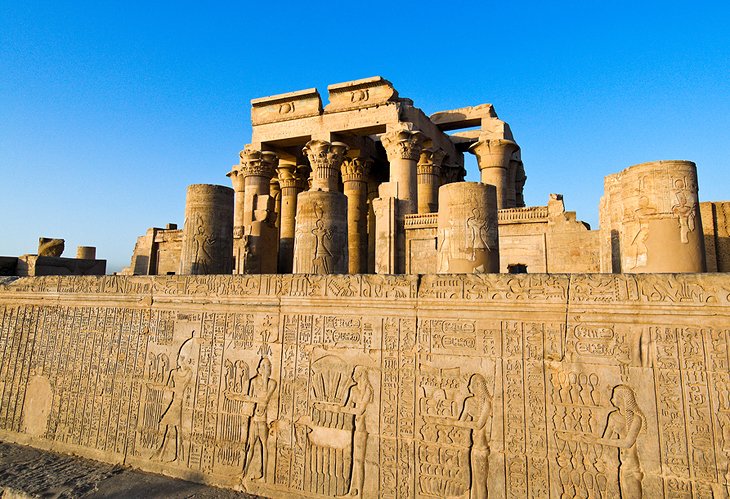
The Ultimate Guide to Visiting Kom Ombo Temple, Egypt
Unusual medical reliefs and references at the temple
Kom Ombo Temple, located in Upper Egypt, is a fascinating archaeological site that offers insight into the ancient world and its connection to medical science. One of the distinctive features of the temple is its unusual reliefs and references to various medical practices of the time. These reliefs depict surgical tools, procedures, and figures associated with healing and medicine. Some of the notable medical reliefs found at the temple include:
-
The Eye of Horus: The Eye of Horus, an ancient Egyptian symbol associated with healing and protection, can be seen in several reliefs at the temple. It was believed to have the power to cure ailments and restore health.
-
Surgeons and Patients: The reliefs also show scenes of surgeons performing medical procedures on patients. This suggests that the priests of Kom Ombo Temple had knowledge of surgical techniques and were involved in treating various ailments.
-
Pharmacy: Another interesting feature is the depiction of a pharmacy with shelves filled with jars and containers. This indicates that the temple served as a place of worship and a centre for distributing medicinal remedies to the community.
Theories surrounding the influence of the temple on ancient medical knowledge
The presence of these medical reliefs at Kom Ombo Temple has sparked various theories about the temple's influence on ancient medical knowledge. Some researchers believe that the temple priests were highly skilled in medical practices and may have even contributed to the development of medical science in ancient Egypt. Other theories suggest the temple was a medical training centre or a place where different medical techniques were shared and exchanged.
It is also worth noting that the temple's proximity to the Nile River played a significant role in understanding and applying medical practices. The Nile River was crucial for agriculture and provided fertile soil, resulting in abundant medicinal plants. The priests of Kom Ombo Temple would have had access to a wide range of natural remedies, enabling them to explore and experiment with different healing methods.
Visiting Kom Ombo Temple is a unique opportunity to explore the intersection of ancient religious practices and medical science. The temple offers a glimpse into the medical knowledge and practices of the time, providing valuable insights into the ancient world's understanding of health and healing.
Plan your visit to Kom Ombo Temple and discover the fascinating connection between ancient Egyptian religion and medical science.
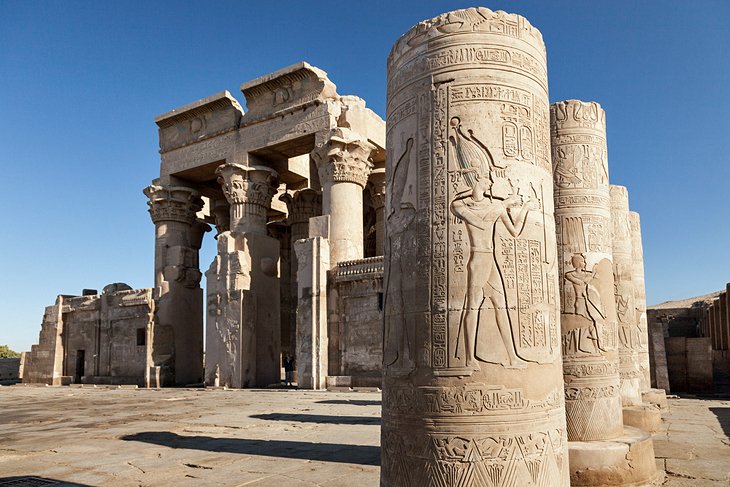
VII. Kom Ombo Temple: Past and Present
The Kom Ombo Temple, located in Egypt, is a fascinating historical site that has undergone various changes and restoration efforts. Here is an overview of the temple's past and present states.
Historical changes and restoration efforts
The Kom Ombo Temple was constructed during the Ptolemaic dynasty, between 180 and 47 BC. Over the centuries, the temple faced significant damage due to natural disasters, such as earthquakes, flooding, and human activities. Egypt's changing political and religious landscape also impacted the temple's use and condition.
In recent years, extensive restoration efforts have taken place to preserve and showcase the temple's historical significance. The restoration projects aim to recreate the temple's original appearance, including its intricate carvings and vibrant colours. Archaeologists and conservationists have worked tirelessly to safeguard the temple for future generations.
The current state of the temple and ongoing preservation projects
Today, the Kom Ombo Temple is a remarkable testament to ancient Egyptian architecture and religious practices. Visitors can explore the temple's various chambers, including the main hall, sanctuary, and hypostyle hall, to gain insight into the religious rituals and beliefs of the time.
Efforts are ongoing to ensure the preservation of the temple. This includes monitoring and maintenance to prevent further deterioration, as well as regular inspections and assessments to identify areas needing attention. Using modern conservation techniques and materials helps maintain the temple's structural integrity while safeguarding its historical features.
Visitors to the Kom Ombo Temple can also learn more about its history through the on-site museum, which displays artefacts discovered during excavation and restoration work. The museum offers a wealth of information about the temple's significance in ancient Egyptian history.
Kom Ombo Temple is a remarkable testament to ancient Egyptian architecture and religious practices. Thanks to restoration efforts, visitors can now experience the temple's past glory and better understand Egypt's rich cultural heritage.

VIII. Visiting Kom Ombo Temple: Practical Information
Opening hours and admission fees
When planning a visit to Kom Ombo Temple, it's important to note the opening hours and admission fees to make the most of your trip. The temple is open daily from 9:00 am to 5:00 pm. The entrance fee for adults is EGP 80 ($5), and for students, it's EGP 40 ($2.50).
Tips for a smooth visit, including dress code and photography rules
To ensure a smooth and enjoyable visit to Kom Ombo Temple, here are some essential tips to keep in mind:
Dress code:
- Dressing modestly and respectfully when visiting religious and historical sites in Egypt is recommended. Women should cover their shoulders and knees, and men should avoid wearing sleeveless shirts.
- Wearing comfortable walking shoes is advisable as the temple grounds can be uneven.
Photography rules:
- Photography is allowed inside Kom Ombo Temple, but tripods and flash photography are generally prohibited.
- Please respect the ancient artefacts and avoid touching or leaning on the temple walls.
Guided tours:
- Consider hiring a knowledgeable guide to enhance your experience at Kom Ombo Temple. They can provide interesting insights and historical context that will enrich your visit.
Food and water:
- It's a good idea to bring a bottle of water with you to stay hydrated during your visit. However, be aware that eating and drinking inside the temple complex is not allowed.
Accessibility:
- Kom Ombo Temple may have some uneven ground and steps, which could make it challenging for visitors with mobility issues. It is advisable to check if the site is accessible to your needs.
Kom Ombo Temple is a remarkable ancient site that offers a glimpse into Egypt's rich history. By following these tips and being prepared, you can make the most of your visit and create lasting memories at this incredible UNESCO World Heritage site.
For more information about Kom Ombo Temple, you can visit https://en.wikipedia.org/wiki/Kom_Ombo.
